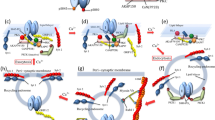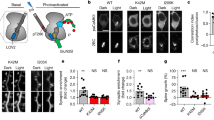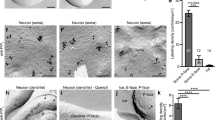Abstract
Long-term potentiation (LTP), a persistent synaptic enhancement thought to be a substrate for memory1, can be divided into two phases: induction, triggering potentiation, and maintenance, sustaining it over time1,2. Many postsynaptic events are implicated in induction, including N-methyl-D-aspartate receptor (NMDAR) activation, calcium increases and stimulation of several protein kinases1; in contrast, the mechanism maintaining LTP is not yet characterized1. Here we show the constitutively active form of an atypical protein kinase C (PKC) isozyme, protein kinase M zeta (PKMζ), is necessary and sufficient for LTP maintenance.
This is a preview of subscription content, access via your institution
Access options
Subscribe to this journal
Receive 12 print issues and online access
$209.00 per year
only $17.42 per issue
Buy this article
- Purchase on Springer Link
- Instant access to full article PDF
Prices may be subject to local taxes which are calculated during checkout



Similar content being viewed by others
References
Malenka, R. C. & Nicoll, R. A. Science 285, 1870–1874 (1999).
Malinow, R., Madison, D. V. & Tsien, R. W. Nature 335, 820–824 (1988).
Schwartz, J. H. & Greenberg, S. M. Annu. Rev. Neurosci. 10, 459–476 (1987).
Nishizuka, Y. FASEB J. 9, 484–496 (1995).
Otmakhov, N., Griffith, L. C. & Lisman, J. E. J. Neurosci. 17, 5357–5365 (1997).
Denny, J. B., Polan-Curtain, J., Rodriguez, S., Wayner, M. J. & Armstrong, D. L. Brain Res. 534, 201–208 (1990).
Sacktor, T. C. et al. Proc. Natl. Acad. Sci. USA 90, 8342–8346 (1993).
Lledo, P. M. et al. Proc. Natl. Acad. Sci. USA 92, 11175–11179 (1995).
Lallena, M. J., Diaz-Meco, M. T., Bren, G., Paya, C. V. & Moscat, J. Mol. Cell. Biol. 19, 2180–2188 (1999).
McGlynn, E. et al. J. Cell. Biochem. 49, 239–250 (1992).
Thompson, L. J. & Fields, A. P. J. Biol. Chem. 271, 15045–15053 (1996).
Shirke, A. M. & Malinow, R. J. Neurophysiol. 78, 2682–2692 (1997).
Bortolotto, Z. A. & Collingridge, G. L. Eur. J. Neurosci. 12, 4055–4062 (2000).
Fukunaga, K. et al. J. Neurochem. 74, 807–817 (2000).
Drier, E. A. et al. Nat. Neurosci. 5, 316–324 (2002).
Acknowledgements
Supported by New York City Council Speaker's Fund for Biomedical Research (D.S.F.L.) and NIMH (L.S.B. and T.C.S.).
Author information
Authors and Affiliations
Corresponding author
Ethics declarations
Competing interests
The authors declare no competing financial interests.
Supplementary information
Supplementary Figure 1.
Silver stain of baculovirus/Sf9-expressed PKMζ used in whole-cell recording pipette. Positions of molecular weight standards in kDa are shown on the left. (PDF 287 kb)
Supplementary Figure 2.
No change in input resistance during potentiation by postsynaptic introduction of PKMζ. Upper graph, time course of the individual experiment shown in Fig. 1a and b (each point represents mean ± SEM of 4 consecutive EPSCs). Lower graph, no change in input resistance. (PDF 211 kb)
Supplementary Figure 3.
Postsynaptic introduction of heat-inactivated PKMζ (0 pmol/min/ml phosphotransferase activity) had no effect on evoked EPSCs. (PDF 203 kb)
Supplementary Figure 4.
Evoked EPSCs potentiated by PKMζ were suppressed by 93.0 ± 1.5% with exposure to 10 µM CNQX, a non-NMDA glutamate receptor antagonist (n = 3), indicating that the enhancement is predominantly of AMPAR responses. (PDF 205 kb)
Supplementary Figure 5.
Potentiation of AMPAR responses by PKMζ was not secondary to activation of NMDARs. (a) Enhancement of EPSCs with intracellular introduction of PKMζ in cells voltage-clamped at -75 mV in the presence of 10 µM CPP. (b) Pooled data of the increase in evoked EPSCs by PKMζ in 10 µM CPP (mean ± SEM; n = 6 experiments). Unpaired t-test of PKMζ-mediated EPSC enhancement 12 min after the onset of whole-cell access showed no significant difference between experiments in the presence or absence of CPP. (PDF 210 kb)
Supplementary Figure 6.
PKMζ potentiated spontaneous EPSCs. (a) Examples of spontaneous events recorded 1 and 10 min after initiation of whole-cell recording with 1.4 nM PKMζ in the pipette. The potentiation of sEPSCs by PKMζ was reversed by 1 µM chelerythrine. (b) Mean ± SEM of sEPSC amplitudes (1 min recording, 347 events; 10 min, 379 events; reversal by chelerythrine, 172 events; p < 0.0001, unpaired t-test between 1 and 10 min and no significant difference between 1 min and chelerythrine reversal). PKMζ did not change the frequency of sEPSCs significantly (98.5% ± 3.7 of initial values, n = 4). (PDF 260 kb)
Supplementary Figure 7.
Whole-cell LTP by 4 tetanic trains paired with postsynaptic depolarization to -40 mV. (a) Representative EPSCs pretetanus (recorded at 10 min of establishing whole-cell access, immediately prior to tetanic stimulation) and posttetanus (30 min). (b) Time course of the individual experiment shown in (a). Each point represents mean ± SEM of 4 consecutive EPSCs. Tetanus is at arrow. (PDF 211 kb)
Supplementary Figure 8.
The synaptic potentiation produced by PKMζ occludes LTP. (a) Upper traces, EPSCs at 1 and 10 min after the initiation of whole-cell recording with PKMζ, and posttetanus, at 30 min. No additional potentiation was observed. Lower traces, simultaneously recorded field potentials showed LTP. (b) Time course of individual experiment shown in (a). In whole-cell recordings, tetanization resulted only in PTP. Inset, time course of LTP in simultaneous field recordings. Each point represents mean ± SEM of 4 consecutive EPSCs. (c) Pooled data showing simultaneous LTP in field recordings from experiments presented in Fig. 2b (mean ± SEM; n = 5 experiments). (PDF 242 kb)
Supplementary Figure 9.
Postsynaptic exposure to the dominant negative inhibitor PKMζ-K281W (20 nM) blocked LTP. (a) Silver stain of baculovirus/Sf9-expressed PKMζ-K281W used in the whole-cell recording pipette. (b) Evoked EPSCs recorded 1 and 10 min after introduction of PKMζ-K281W with cells held at -40 mV showed no obvious effect on synaptic responses mediated by AMPA and NMDARs. PKMζ-K281W also had no effect on passive membrane properties (not shown). (c) Upper traces, whole-cell EPSCs pre- and posttetanization, showing no persistent potentiation after exposure to PKMζ-K281W. Lower traces, simultaneously recorded field potentials showed LTP. (d) Time course of the individual experiment shown in (c). Each point represents mean ± SEM of 4 consecutive EPSCs. Tetanization resulted only in PTP. Inset, time course of simultaneous field recording showed LTP. (e) Pooled data showing simultaneous LTP in field recordings from experiments presented in Fig. 2c (mean ± SEM; n = 5 experiments). Whole-cell experiments immediately before and after those with PKMζ-K281W showed normal LTP. (PDF 358 kb)
Supplementary Figure 10.
Persistent phosphorylation by PKMζ is necessary for LTP maintenance. (a) Staurosporine (100 nM in 0.001% DMSO) applied prior to the tetanic stimulation blocked the induction of LTP. Pooled field recording data are mean ± SEM of 4 experiments. (b) Representative field potential traces showing 1 min pretetanus, 1 hr posttetanus (immediately prior to drug application), and 5 hr posttetanus. Above, staurosporine (100 nM in 0.001% DMSO); center, chelerythrine (1 µM in 0.001% DMSO); below, myristoylated ζ-pseudosubstrate peptide (1 µM). For data presented in Fig. 3, one-way ANOVA showed significant differences among DMSO alone, staurosporine, chelerythrine, and ζ-pseudosubstrate peptide, 4 hr post-application [F(3, 14) = 10.11, p = 0.0008]. Post hoc unpaired t-test showed significant differences for both chelerythrine and ζ-pseudosubstrate peptide compared to both DMSO and staurosporine (p < 0.01). No significant differences were observed between DMSO and staurosporine, and between chelerythrine and ζ-pseudosubstrate peptide. Staurosporine effectively inhibited conventional PKCα, novel PKCε, and CaMKII at low nanomolar concentrations, but was ineffective on PKMζ up to 100 nM (n = 3; the SEM, not shown for clarity in Fig. 3, were less than 30% of the means for all data points; p < 0.02, Wilcoxon's independent samples test, PKMζ compared to PKCα, PKCε and CaMKII). Chelerythrine inhibited PKMζ at lower concentrations than that required to inhibit PKCα, PKCε, and CaMKII (n = 3; p < 0.02). The myristoylated ζ-pseudosubstrate peptide selectively inhibited PKMζ relative to CaMKII (n = 3; p < 0.02). (GIF 18 kb)
Rights and permissions
About this article
Cite this article
Ling, D., Benardo, L., Serrano, P. et al. Protein kinase Mζ is necessary and sufficient for LTP maintenance. Nat Neurosci 5, 295–296 (2002). https://doi.org/10.1038/nn829
Received:
Accepted:
Published:
Issue Date:
DOI: https://doi.org/10.1038/nn829
This article is cited by
-
Synaptic tau: A pathological or physiological phenomenon?
Acta Neuropathologica Communications (2021)
-
Modeling suggests combined-drug treatments for disorders impairing synaptic plasticity via shared signaling pathways
Journal of Computational Neuroscience (2021)
-
GSK-3β activation is required for ZIP-induced disruption of learned fear
Scientific Reports (2020)
-
Role of prelimbic cortex PKC and PKMζ in fear memory reconsolidation and persistence following reactivation
Scientific Reports (2020)
-
Neurogenetic Technologies for Research on the Mechanisms Maintaining Memory
Neuroscience and Behavioral Physiology (2020)



